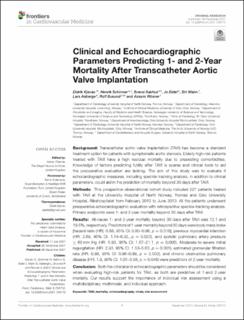| dc.description.abstract | Background: Transcatheter aortic valve implantation (TAVI) has become a standard treatment option for patients with symptomatic aortic stenosis. Elderly high-risk patients treated with TAVI have a high residual mortality due to preexisting comorbidities. Knowledge of factors predicting futility after TAVI is sparse and clinical tools to aid the preoperative evaluation are lacking. The aim of this study was to evaluate if echocardiographic measures, including speckle-tracking analysis, in addition to clinical parameters, could aid in the prediction of mortality beyond 30 days after TAVI. Methods: This prospective observational cohort study included 227 patients treated with TAVI at the University Hospital of North Norway, Tromsø and Oslo University Hospital, Rikshospitalet from February 2010 to June 2013. All the patients underwent preoperative echocardiographic evaluation with retrospective speckle-tracking analysis. Primary endpoints were 1- and 2-year mortality beyond 30 days after TAVI. Results: All-cause 1- and 2-year mortality beyond 30 days after TAVI was 12.1 and 19.5%, respectively. Predictors of 1-year mortality beyond 30 days were body mass index [hazard ratio (HR): 0.88, 95% CI: 0.80–0.98, p = 0.018], previous myocardial infarction (HR: 2.69, 95% CI: 1.14–6.32, p = 0.023), and systolic pulmonary artery pressure ≥ 60 mm Hg (HR: 5.93, 95% CI: 1.67–21.1, p = 0.006). Moderate-to-severe mitral regurgitation (HR: 2.93, 95% CI: 1.53–5.63, p = 0.001), estimated glomerular filtration rate (HR: 0.98, 95% CI: 0.96–0.99, p = 0.002), and chronic obstructive pulmonary disease (HR: 1.9, 95% CI: 1.01–3.58, p = 0.046) were predictors of 2-year mortality. Conclusion: Both the clinical and echocardiographic parameters should be considered when evaluating high-risk patients for TAVI, as both are predictive of 1-and 2-year mortality. Our results support the importance of individual risk assessment using a multidisciplinary, multimodal, and individual approach. | en_US |

